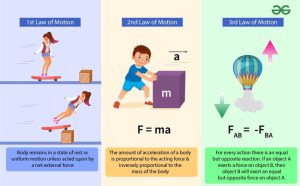Introduction
Newton’s laws of motion form the foundation of classical mechanics, a crucial aspect of mechanical engineering. These laws describe the relationship between forces and motion, providing engineers with the principles necessary to design and analyze mechanical systems. This article explores Newton’s three laws and their significance in mechanical engineering applications.

Newton’s First Law: Law of Inertia
Statement:
An object at rest stays at rest, and an object in motion remains in motion with the same velocity unless acted upon by an external force.
Importance in Mechanical Engineering:
- Structural Stability: Engineers use this law to analyze equilibrium conditions in structures and machinery.
- Vehicle Dynamics: Helps in understanding braking, acceleration, and stability of vehicles.
- Machine Design: Ensures that components maintain stability under operational conditions.
Newton’s Second Law: Law of Acceleration
Statement:
The acceleration of an object is directly proportional to the net force applied and inversely proportional to its mass, expressed as: where is the force, is the mass, and is the acceleration.
Importance in Mechanical Engineering:
- Force Analysis: Essential for designing load-bearing structures and mechanical systems.
- Dynamics of Machinery: Used to determine forces in moving parts like gears, pulleys, and linkages.
- Aerospace and Automotive Engineering: Critical in optimizing propulsion systems and crash impact studies.
Newton’s Third Law: Action and Reaction
Statement:
For every action, there is an equal and opposite reaction.
Importance in Mechanical Engineering:
- Propulsion Systems: Fundamental in designing engines, rockets, and propulsion units.
- Structural Load Distribution: Helps in ensuring stability and efficiency of load-bearing structures.
- Mechanical Linkages and Joints: Crucial in analyzing forces in gears, levers, and robotic arms.
Applications in Mechanical Engineering
- Automobile Engineering: Used to design safer and more efficient braking and suspension systems.
- Robotics and Automation: Helps in programming robotic arms and analyzing movement dynamics.
- Material Science: Aids in understanding stress-strain behavior under applied forces.
- Aerospace Engineering: Essential in flight dynamics and spacecraft propulsion.
- Manufacturing and Machinery: Ensures proper force transmission in mechanical components.
Conclusion
Newton’s laws of motion are indispensable in mechanical engineering, providing the theoretical foundation for designing, analyzing, and improving mechanical systems. Understanding and applying these principles allows engineers to create safer, more efficient, and innovative mechanical solutions across various industries


